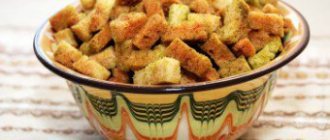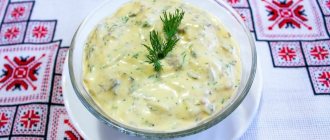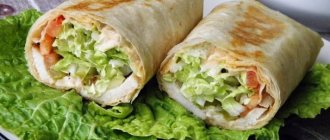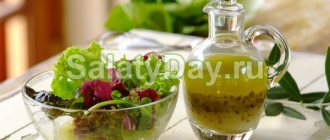Classic miso - dietary option
- 150 g tofu;
- 20 ml dasha;
- 140 g miso;
- 35 g wakame;
- 20 g green onions;
- 1 liter of spring water.
Cooking traditional yushka is not difficult. It can be used for weight loss, because it contains only fish broth, sea shoots and cheese. It does not contain fat and is considered dietary.
First, prepare the liquid base. We put granulated dashi into boiling water, but many people have adapted to cook it at home using kombu.
It is impossible to prepare misoshiri at home without seaweed. Fill the dry stems with a small amount of water. Cut the cheese into medium cubes and place in a saucepan.
We add the swollen sea leaves to a vegetarian stew, continuing to prepare it at home. To make a delicious soup at home, dilute the paste, which has a pungent piquant aroma, with liquid until smooth. Set the saucepan aside and pour in the diluted mixture, as in the photo. Stir the Chinese instant soup, distribute into bowls, garnish with green onions.
Having described a step-by-step classic recipe at home, we see that this is a simple option that has deservedly received many positive reviews.
We recommend a dietary recipe from Spain Lenten recipe for gazpacho.
Miso soup recipe. Calorie, chemical composition and nutritional value.
Nutritional value and chemical composition of "Miso soup".
The table shows the nutritional content (calories, proteins, fats, carbohydrates, vitamins and minerals) per 100 grams of edible portion.
| Nutrient | Quantity | Norm** | % of the norm in 100 g | % of the norm in 100 kcal | 100% normal |
| Calorie content | 38.7 kcal | 1684 kcal | 2.3% | 5.9% | 4351 g |
| Squirrels | 3.6 g | 76 g | 4.7% | 12.1% | 2111 g |
| Fats | 1.5 g | 56 g | 2.7% | 7% | 3733 g |
| Carbohydrates | 3 g | 219 g | 1.4% | 3.6% | 7300 g |
| Alimentary fiber | 0.1 g | 20 g | 0.5% | 1.3% | 20000 g |
| Water | 91.2 g | 2273 g | 4% | 10.3% | 2492 g |
| Ash | 0.484 g | ~ | |||
| Vitamins | |||||
| Vitamin A, RE | 0.5 mcg | 900 mcg | 0.1% | 0.3% | 180000 g |
| beta carotene | 0.005 mg | 5 mg | 0.1% | 0.3% | 100000 g |
| Vitamin B1, thiamine | 0.033 mg | 1.5 mg | 2.2% | 5.7% | 4545 g |
| Vitamin B2, riboflavin | 0.047 mg | 1.8 mg | 2.6% | 6.7% | 3830 g |
| Vitamin B4, choline | 1.72 mg | 500 mg | 0.3% | 0.8% | 29070 g |
| Vitamin B5, pantothenic | 0.06 mg | 5 mg | 1.2% | 3.1% | 8333 g |
| Vitamin B6, pyridoxine | 0.022 mg | 2 mg | 1.1% | 2.8% | 9091 g |
| Vitamin B9, folates | 1.641 mcg | 400 mcg | 0.4% | 1% | 24375 g |
| Vitamin C, ascorbic acid | 0.57 mg | 90 mg | 0.6% | 1.6% | 15789 g |
| Vitamin E, alpha tocopherol, TE | 0.061 mg | 15 mg | 0.4% | 1% | 24590 g |
| Vitamin H, biotin | 0.006 mcg | 50 mcg | 833333 g | ||
| Vitamin K, phylloquinone | 0.4 mcg | 120 mcg | 0.3% | 0.8% | 30000 g |
| Vitamin RR, NE | 0.274 mg | 20 mg | 1.4% | 3.6% | 7299 g |
| Niacin | 0.064 mg | ~ | |||
| Betaine | 0.604 mg | ~ | |||
| Macronutrients | |||||
| Potassium, K | 56.34 mg | 2500 mg | 2.3% | 5.9% | 4437 g |
| Calcium, Ca | 4.63 mg | 1000 mg | 0.5% | 1.3% | 21598 g |
| Silicon, Si | 1.736 mg | 30 mg | 5.8% | 15% | 1728 g |
| Magnesium, Mg | 5.6 mg | 400 mg | 1.4% | 3.6% | 7143 g |
| Sodium, Na | 125.85 mg | 1300 mg | 9.7% | 25.1% | 1033 g |
| Sera, S | 9.78 mg | 1000 mg | 1% | 2.6% | 10225 g |
| Phosphorus, P | 7.8 mg | 800 mg | 1% | 2.6% | 10256 g |
| Chlorine, Cl | 3.32 mg | 2300 mg | 0.1% | 0.3% | 69277 g |
| Microelements | |||||
| Aluminium, Al | 29.9 mcg | ~ | |||
| Bor, B | 4 mcg | ~ | |||
| Vanadium, V | 5.17 mcg | ~ | |||
| Iron, Fe | 0.393 mg | 18 mg | 2.2% | 5.7% | 4580 g |
| Yod, I | 0.2 mcg | 150 mcg | 0.1% | 0.3% | 75000 g |
| Cobalt, Co | 0.281 mcg | 10 mcg | 2.8% | 7.2% | 3559 g |
| Lithium, Li | 2.674 mcg | ~ | |||
| Manganese, Mn | 0.0474 mg | 2 mg | 2.4% | 6.2% | 4219 g |
| Copper, Cu | 82.82 mcg | 1000 mcg | 8.3% | 21.4% | 1207 g |
| Molybdenum, Mo | 0.278 mcg | 70 mcg | 0.4% | 1% | 25180 g |
| Nickel, Ni | 0.174 mcg | ~ | |||
| Rubidium, Rb | 17.4 mcg | ~ | |||
| Selenium, Se | 0.103 mcg | 55 mcg | 0.2% | 0.5% | 53398 g |
| Strontium, Sr | 0.32 mcg | ~ | |||
| Fluorine, F | 50.49 mcg | 4000 mcg | 1.3% | 3.4% | 7922 g |
| Chromium, Cr | 0.35 mcg | 50 mcg | 0.7% | 1.8% | 14286 g |
| Zinc, Zn | 0.067 mg | 12 mg | 0.6% | 1.6% | 17910 g |
| Zirconium, Zr | 0.11 mcg | ~ | |||
| Digestible carbohydrates | |||||
| Starch and dextrins | 0.825 g | ~ | |||
| Mono- and disaccharides (sugars) | 0.1 g | max 100 g | |||
| Glucose (dextrose) | 0.041 g | ~ | |||
| Sucrose | 0.037 g | ~ | |||
| Fructose | 0.006 g | ~ | |||
| Essential amino acids | 0.042 g | ~ | |||
| Arginine* | 0.061 g | ~ | |||
| Valin | 0.052 g | ~ | |||
| Histidine* | 0.017 g | ~ | |||
| Isoleucine | 0.047 g | ~ | |||
| Leucine | 0.073 g | ~ | |||
| Lysine | 0.049 g | ~ | |||
| Methionine | 0.016 g | ~ | |||
| Methionine + Cysteine | 0.003 g | ~ | |||
| Threonine | 0.044 g | ~ | |||
| Tryptophan | 0.014 g | ~ | |||
| Phenylalanine | 0.043 g | ~ | |||
| Phenylalanine+Tyrosine | 0.011 g | ~ | |||
| Nonessential amino acids | 0.068 g | ~ | |||
| Alanin | 0.061 g | ~ | |||
| Aspartic acid | 0.093 g | ~ | |||
| Glycine | 0.046 g | ~ | |||
| Glutamic acid | 0.139 g | ~ | |||
| Proline | 0.042 g | ~ | |||
| Serin | 0.048 g | ~ | |||
| Tyrosine | 0.039 g | ~ | |||
| Cysteine | 0.011 g | ~ | |||
| Saturated fatty acids | |||||
| 14:0 Miristinovaya | 0.001 g | ~ | |||
| 16:0 Palmitinaya | 0.033 g | ~ | |||
| 18:0 Stearic | 0.002 g | ~ | |||
| Monounsaturated fatty acids | 0.019 g | min 16.8 g | 0.1% | 0.3% | |
| 16:1 Palmitoleic | 0.004 g | ~ | |||
| 18:1 Oleic (omega-9) | 0.015 g | ~ | |||
| Polyunsaturated fatty acids | 0.033 g | from 11.2 to 20.6 g | 0.3% | 0.8% | |
| 18:2 Linolevaya | 0.023 g | ~ | |||
| 18:3 Linolenic | 0.014 g | ~ |
The energy value of Miso soup is 38.7 kcal.
Primary Source: Created in the application by the user. Read more.
** This table shows the average levels of vitamins and minerals for an adult. If you want to know the norms taking into account your gender, age and other factors, then use the “My Healthy Diet” application.
Miso soup with mushrooms
The stew with pieces of cheese, sea leaves and mushrooms is cooked quickly, and its calorie content is so low that it will not harm your figure.
Wash the shiitakes, pour boiling water into the container, leave covered for 10 minutes.
At the same time, soak the wakame in cold water for 10 minutes. Alternatively, vegan soup can be prepared using regular sushi nori, after chopping them into strips.
Pour the water with shiitake into a two-liter saucepan. If necessary, add water to a liter and cook on low heat for 10 minutes. Shiitake can be replaced with oyster mushrooms or black muer.
Pour 250 ml of water into the paste and grind until smooth.
Carefully cut the tofu into cubes. Drain the seaweed and squeeze it out.
Add dashi granules to the prepared mushrooms, stir thoroughly, then pour in the diluted paste and wakame. Bring the soup to a boil and immediately add the tofu. Place the mushroom soup aside, cover and leave for 7 minutes.
The prepared recipe, as in the photo, is served hot in small ceramic bowls.
You can also prepare the traditional first course: Lenten cabbage soup with fresh cabbage, beans and mushrooms.
Miso soup with snapper
Another simple recipe for the main soup of Japan - miso. You can prepare such a delicious dish using a simple recipe in just 10 minutes, and the soup will impress with its unique taste and aroma.
Ingredients:
- small perch - 4 pcs.;
- myoga (vegetable from Japan) - 2 pcs.;
- hachomiso - 2 tbsp;
- dashi broth - 700 ml;
- salt and konazansho seasoning to taste.
Preparation:
Grill the perch until golden brown. Slice the aromatic myoga thinly and soak it in water for a few minutes.
Meanwhile, place a saucepan with dashi broth and bring to a boil, after which you need to add miso paste.
Place the fried perch and myogu in a bowl and pour over the soup. Sprinkle konazansho on top for a richer flavor.
Miso soup with shrimp
The calorie content of the recipe with seafood and shrimp is 50 kcal per 100 grams, so the dish can be called dietary.
Soak dry mushrooms for an hour in hot water. Pour a liter of water into a saucepan, add granulated broth, and place on the stove. Place chopped mushrooms in the prepared broth; you can add a little aromatic mushroom broth. Cook the base for the soup with shrimp and noodles after boiling for 3 minutes.
Cut the cheese into cubes. Thaw the shrimp and clean them. We send these ingredients to the pan along with funchose, which we first chop a little.
Place the pasta in the pan with seafood and immediately turn off the heat. Serve each serving with an egg, sprinkled with sesame seeds and chopped onion feathers.
You can also prepare the Spanish dish Gazpacho with shrimp.
How to cook “Classic Miso soup”
1
Place the wakame in a bowl, add warm water to cover the seaweed by 1 centimeter, leave for 15 minutes.
2
Then place the seaweed in a sieve and get rid of excess liquid.
3
Mix 0.5 cup dashi broth with miso paste to form a smooth mixture.
4
Pour the rest of the broth into a saucepan and place over high heat. Finely chop the green onions.
5
Cut the cheese into small cubes, then add to the boiling broth, and don’t forget about the seaweed.
6
Cook for 1 minute, then remove from heat and add onion, remaining broth and pasta to the pan, stir.
7
Pour the soup into bowls and serve. Bon appetit!
Miso soup with chicken
We start preparing a step-by-step recipe at home with chicken by cooking the broth. Chop the thigh into several parts, wash it, put it in a saucepan with boiling water, and boil until tender.
Transfer the finished bird to a separate bowl, add water, sake and dashi. After the first signs of boiling, cook the contents with the chicken for half an hour.
We clean and chop the daikon with gobo into thin strips and place it in the pan with the chicken. After 12 minutes, add the pasta and soy wheat.
Cook the soup for another quarter of an hour, set aside and leave for 20 minutes. Serve with mitsuba.
Soup with tofu and shiitake mushrooms
For 4 servings of stew you will need:
- liter of water;
- 5 tablespoons of Wakame seaweed;
- 800 g shiitake mushrooms;
- 350 g cheese curd;
- 45 g dasha granules;
- 95 g paste.
Manufacturing stages:
- First you need to wash the mushrooms thoroughly and pour boiling water over them. Leave for ten minutes covered.
- Soak the seafood product for the same period of time. Then strain and squeeze them.
- Place the water with the mushrooms on low heat, bring to a boil and add the pasta. Mix well.
- Boil for 10 minutes , add granules, seaweed, diced tofu. Remove from heat and leave to steep for seven minutes.
Note. Shiitake can be replaced with oyster mushrooms
Miso soup recipe at home is served hot in ceramic plates. The Japanese also prefer to eat it with Hokkaido milk bread.
Miso soup with salmon
Before you start preparing salmon soup at home, you need to marinate the fish in advance. Cut the fillet from the skin, cut into pieces, sprinkle with coarse salt. Let the fish marinate for 2 hours in the refrigerator. Then we wash the salmon, dry it, and fry it on the grill to reduce calories and not use oil. You can do the same with salmon.
We continue to prepare fish soup step by step. Wash and boil the rice until done. Mix it with fish. Finely chop the nori, add water, and heat until it boils. Add dried tuna, diced cheese, sauce and pasta. Stir and remove from heat.
Pour the broth into a container with rice, sprinkle the chowder with salmon and tofu with sesame seeds, add ginger. This completes the recipe with salmon and rice. We serve it immediately.
We recommend preparing an equally delicious dish from Finland - Creamy Salmon Soup Recipe.
About the benefits of miso soup
This is a very healthy dish with an original taste.
The main ingredients of the soup are katsu - skipjack tuna, kombu - seaweed, and miso - a thick paste made by fermenting rice, wheat or legumes mixed with sea salt and koji-kin fungus. The result is a thick mass of homogeneous consistency. Miso paste contains a lot of protein, vitamins and microelements. It improves digestion and strengthens the human immune system. The paste is considered a living product and is added to the finished miso soup only towards the end of cooking, so as not to destroy the healing properties of this product with high temperature. Miso soup is served along with rice and small snacks. Japanese scientists are convinced that the longevity of their fellow citizens is a consequence of daily consumption of miso soup.
In Japan itself, mostly fresh fish and seaweed are used for miso soup. Residents of this country do not like to eat processed foods and foods with added preservatives. However, Japanese living abroad often use dried fish, canned seaweed and other products to prepare their favorite national dishes.











